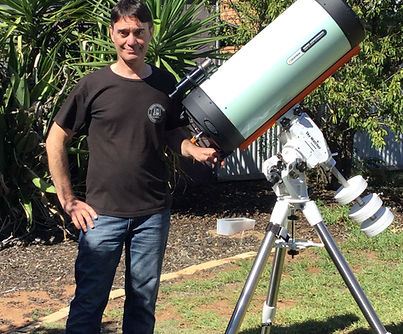Meet the Team
We have a team of eight, but we're always happy to welcome anyone who is interested in writing about astronomy and science. If you are keen on writing for the Southern Astronomer, or if you have experience with InDesign, please email
editor @ southernastronomer dot com

Stephi Bernard
Stephanie Bernard is an astronomy and space science educator in Melbourne, Australia. She teaches observational astrophysics and cultural astronomy to undergraduates at the University of Melbourne, and also works as a presenter and educator at Scienceworks, the Melbourne Planetarium, and the Victorian Space Science Education Centre.
Her research interests in astronomy are in stars and galaxies in the early Universe with space telescopes, which she studied for a Master of Science in Physics and a long-abandoned PhD, and she is especially interested in the next generation of both space- and ground-based telescopes.
She also loves talking to astrophysicists and other astronomy enthusiasts on her podcast Spaghettification. Aside from astronomy, her main loves are her six cats and knitting a million jumpers in bright colours.

Tim Davis
Tim obtained a Bachelor of Science with Honours in physics and then a PhD in experimental gravitation from the University of Melbourne. He worked at CSIRO for 29 years doing pure and applied research in many fields, running a microfabrication laboratory, and leading science research groups.
During this time, he was actively involved in science outreach, giving public talks on science, contributing to The Conversation, and taking on the roles of Victorian Branch Secretary, Chairman and Convenor of the Science Policy Committee in the Australian Institute of Physics. He left CSIRO in 2015, where he began consulting work, travelling to Germany to research nano-optics at the universities in Stuttgart and Duisburg for industry and holds a Mercator Fellowship. He has published over 130 papers in scientific journals, including in the high-profile journals Nature and Science.
He is a member of the Australian and New Zealand Optical Society, Optica (formerly the Optical Society of America) and the European Physical Society. He joined the Astronomical Society of Victoria in 2022 where he is active in the Radio Astronomy Section.

Kate Green
Kate Green is a passionate advocate for STEAM education in schools – particularly for girls – through her role as Space Exploration Section Director for the Astronomical Society of Victoria (ASV), undertaking talks and presentations to ASV members, the general public and schools. Her passion for Space Exploration and Astronomy was nurtured from an early age through her Great Gran, who taught her the constellations and their stories and purchased Kate her first telescope so they could see Halley’s Comet together in 1986.
Inspired by correspondence with NASA, Kate developed a passion for Space Exploration – both human and robotic – which was reinforced by the 1980 “Cosmos” series by Carl Sagan. A career in Nursing and raising a family placed Astronomy and Space Exploration on hold for several years. This passion was re-ignited with joining the Astronomical Society of Victoria (ASV) in 2020 – with Kate stepping into the Society’s Space Exploration Section Director role in 2022.
Due to her Nursing background, Kate is particularly interested in human space exploration and its impact on the body as we look to set up a human colony on the Moon and beyond. Kate has an Arts Degree (Sociology / Behavioural Studies).

Steve de Lisle
Steve de Lisle is a passionate amateur astronomer with over 50 years of experience observing the night sky.
Steve is married with three grown children and has four grandchildren. His main interest is astrophotography and cosmology.
Professionally, he is a retired clinical psychologist and enjoys writing.

Michael Mattiazzo
Michael became hooked on comets after observing the first and most famous periodic comet, 1P Halley, in 1986. Since then, he has visually observed and photographed well over 250 comets.
He was mentored by one of the most significant visual comet hunters of all time, Bill Bradfield. Michael's focus on confirming SWAN comets led to him being the first person in the world to visually observe C/2004 H6 SWAN, using a pair of 25x100mm binoculars.
Michael is now credited with the discovery of nine SWAN comets. He is currently a member of both ASSA and ASV and resides in Swan Hill, regional Victoria, managing a hospital pathology lab while continuing his creative pursuits.

Tony Neilson
Tony developed an early love of science fiction and science, which stayed with him through a professional career that diverged wildly from where he thought it might take him.
He designed and constructed RF detectors to observe pulsars during his physics honours year at the University of Tasmania before completing a PhD in laser physics at the University of Southampton (UK).
On his return to Melbourne, Tony worked in a wide range of corporate roles, spending the last few decades in telecommunications regulation. He recently retired and hopes to spend more time writing science fiction and astrophotography.

Kevin Orrman-Rossiter
Like most of us, Kevin wanted to be an astronaut as a four-year-old. He grew up going to school interspersed with larking around with friends,
occasionally setting alight the bedroom mat with an out-of-control chemistry set, chipping
away at rocks with a geology pick, vainly searching for fossils and looking at the moon and
stars with what would possibly be now called a “hobby-killer” telescope.
He decided that university physics would be the way to go to understand the world, then
discovered along the way that I was very good at experimental physics. So, of course, after
‘mastering’ applied physics, earning a PhD and a Queen Elizabeth II Fellowship, he naturally
left academia and joined industry (the dark side as it was then called by many of his
academic colleagues), firstly as an R&;D scientist then other things including being a
‘consultant’. After a while, he re-grounded himself, rediscovering his love of thinking, of science, of communicating science - this is me now. He lives in inner-city Melbourne and is happily married. He owns a solar telescope.

